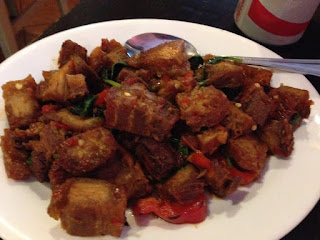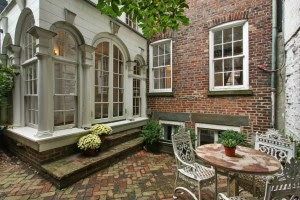I am a hopeless foodie with a culinary degree. I am a native New Yorker. I am a licensed Tour Guide in New York City. I have worked as a Hotel Concierge. I am fluent in five languages. I have been called a know-it-all. Certainly that was intended to offend me, but, ironically, it is very much in my job description, a term which I embrace. And I try to improve and know more every time I have a bite to eat.
New York City is a place where people of all types converge. People of all types: big and small; rich and poor; native and not; representing every color of the spectrum, from every nation on Earth and every religious persuasion; natives, residents and tourists alike. How lucky I am to be able to sample the world’s most exotic cuisines yet be only a subway ride away from home. What a very exciting place to be indeed!
I enjoy venturing into the unknown. So, in my quest to
know-it-all about food, and about New York, I see an ethnic neighborhood, I
visit it; I see an ethnic market, I enter it, and I peruse the aisles; I see an
unfamiliar ingredient, I pick it up and read the label. Then I try to imagine
how I can incorporate it into a recipe, even if what I do with it may not be
that ingredient’s intended purpose.
New York is my kaleidoscope, ever colorful and ever changing. It is not the “mosaic” I have heard people refer to. Once a mosaic is created, it is looked at and admired for posterity, but never changed. Some cities are like that, a work of art; Venice, Rome, Paris, Florence, Barcelona, Madrid and dozens more. You visit them, and inevitably you take a part of them back home with you. I would not want to return to these places to see how they have evolved, to see how they have changed. In fact, if they did evolve and change I would be devastated. I would feel as if a part of me has disappeared. Some places are better left untouched. Leave modernity for the new.
New York is a very different story. The city constantly changes. Author O'Henry once said, "New York will be a great place, once they finish it." How right he was! Here people come and people go. As older ethnicities move away, others move in to take their place. I have seen many a New York pizzeria close shop only to be replaced by a taquería. The once ubiquitous hot dog carts have all but disappeared, only to be replaced by Halal food vending carts, serving sumptuous grilled chicken, falafel, gyros and other Middle-Eastern delicacies. The aroma of steaming hot dogs, and burning pretzels and warm roasted chestnuts that warm the soul on a cold winter’s day (yes, that smell that most attribute to chestnuts roasting on an open fire is actually the smell of yesterday’s stale pretzels being burned and used as fuel together with charcoal!! Genius!) is now being replaced by savory grilled meats seasoned with garlic and savory spices.
New York is my kaleidoscope, ever colorful and ever changing. It is not the “mosaic” I have heard people refer to. Once a mosaic is created, it is looked at and admired for posterity, but never changed. Some cities are like that, a work of art; Venice, Rome, Paris, Florence, Barcelona, Madrid and dozens more. You visit them, and inevitably you take a part of them back home with you. I would not want to return to these places to see how they have evolved, to see how they have changed. In fact, if they did evolve and change I would be devastated. I would feel as if a part of me has disappeared. Some places are better left untouched. Leave modernity for the new.
New York is a very different story. The city constantly changes. Author O'Henry once said, "New York will be a great place, once they finish it." How right he was! Here people come and people go. As older ethnicities move away, others move in to take their place. I have seen many a New York pizzeria close shop only to be replaced by a taquería. The once ubiquitous hot dog carts have all but disappeared, only to be replaced by Halal food vending carts, serving sumptuous grilled chicken, falafel, gyros and other Middle-Eastern delicacies. The aroma of steaming hot dogs, and burning pretzels and warm roasted chestnuts that warm the soul on a cold winter’s day (yes, that smell that most attribute to chestnuts roasting on an open fire is actually the smell of yesterday’s stale pretzels being burned and used as fuel together with charcoal!! Genius!) is now being replaced by savory grilled meats seasoned with garlic and savory spices.
Does this disappoint me? Sure. In a way. But a kaleidoscope
is always changing. And it would not be near as exciting if it all just stayed
the same. But as far as
the hot dog vendors are concerned, what I miss most from those steamy hot dog
carts is the home-made saucy red onions. Sure, you can buy commercially
prepared versions in the hot dog section of most supermarkets, but I was lucky
to learn a recipe from an actual vendor, which I will share with you later on.
New Yorkers
take many things for granted, and don’t give a second thought, that is until we
cannot find it anymore. Then the nostalgia kicks in. “Real” New York pizza.
Authentic New York bagels. Pickles sold from a barrel. A towering sandwich of buttery tender pastrami from
our famed “delicatessens,” (never to
be confused with a “deli sandwich,” for a corner deli is never to be confused
with a sit-down delicatessen). A
proper bowl of Matzo Ball Soup. What about those Onion and Garlic flavored potato chips? Can't find them everywhere. And I am not talking solely about ex-pats who have moved
away and long for the tastes of home. I am also talking about New Yorkers who still live here. Some of these things are woefully
disappearing right before our very eyes.
People ask me all the time. "Where can I walk around, see nice homes, brownstones and quaint neighborhoods?" Immediately the West Village comes to mind. I have conducted walking tours of the area hundreds of times, so I have written it down to share. People ask me how to go to the #7 train. I ask them, "Going to the Open, or CityField?" They tell me they are going to look at the street art. Well, there's a lot more than graffiti to see along the #7 line.
I know many New York ex-pats living in other places that long for the flavors and stories from home. I was one of them. More than once I have lived afar. Home was not Los Angeles, or Las Vegas. Oh, I have many great memories of those places, but it wasn't home. They were just places where I lived for a time. But I have resumed a life back home. Now I share it with you, on this blog.
People ask me all the time. "Where can I walk around, see nice homes, brownstones and quaint neighborhoods?" Immediately the West Village comes to mind. I have conducted walking tours of the area hundreds of times, so I have written it down to share. People ask me how to go to the #7 train. I ask them, "Going to the Open, or CityField?" They tell me they are going to look at the street art. Well, there's a lot more than graffiti to see along the #7 line.
I know many New York ex-pats living in other places that long for the flavors and stories from home. I was one of them. More than once I have lived afar. Home was not Los Angeles, or Las Vegas. Oh, I have many great memories of those places, but it wasn't home. They were just places where I lived for a time. But I have resumed a life back home. Now I share it with you, on this blog.
This blog is for foodies. This blog is for New Yorkers. This blog is for New Yorkers who have moved away. This blog is for people who have ever visited New York. This blog is for tourists in New York right now. This blog is for the French and German families I see venturing for a ride on the #7 train to see the street art who maybe, just maybe will get out of those shiny metal boxes and descend to explore the wonders that await them on the streets below. This blog is for me, as well, because I enjoy sharing my experiences with others. So, now, instead of just printing my walking tour for my hotel guests, or telling the French family how to get to the 7 train I can just send them a link to this blog, hope they like it and share with their friends. My goal is to have this blog reach all the inhabited continents.
So I would like to invite you to follow along with me on my tour as we trot the globe visiting my favorite places in the City, learn a little history, about food. We will explore different neighborhoods, visit their markets and delve into their immigrant past and present. But you can leave your passports home. Just bring your MetroCard...and an appetite. Come along!
So I would like to invite you to follow along with me on my tour as we trot the globe visiting my favorite places in the City, learn a little history, about food. We will explore different neighborhoods, visit their markets and delve into their immigrant past and present. But you can leave your passports home. Just bring your MetroCard...and an appetite. Come along!


















































